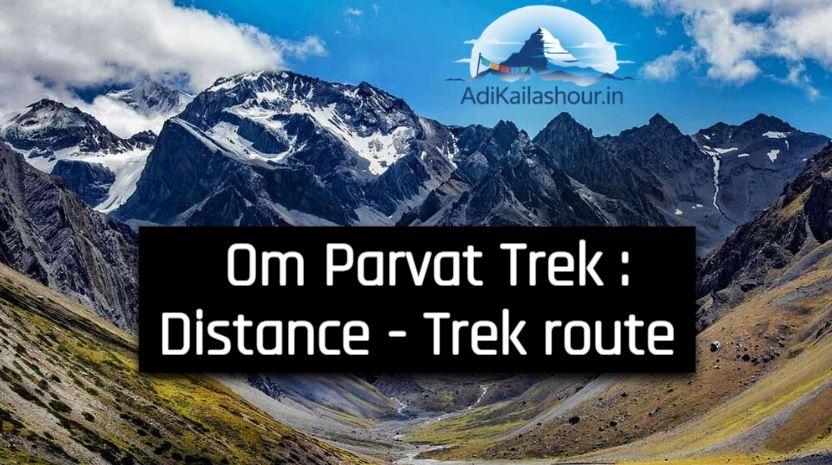The Om Parvat trek is a remarkable pilgrimage and trekking experience nestled in the magnificent Himalayas of Uttarakhand, India. Known for the naturally occurring ॐ (Om) symbol formed by snow on the Om Parvat mountain, this trek attracts spiritual seekers, adventurers, and nature lovers alike. Combining breathtaking landscapes, cultural heritage, and spiritual significance, the Om Parvat trek offers a unique journey that is both physically fulfilling and soul-enriching.
All You Should Know Of Om Parvat Trek
Om Parvat is located near the Indo-Tibetan border in the Pithoragarh district of Kumaon, Uttarakhand. It is closely associated with the Adi Kailash, or Chhota Kailash, shrine, which is considered the smaller replica of the revered Mount Kailash. The trek to Om Parvat is often part of a larger pilgrimage circuit known as the Adi Kailash Yatra. Trekkers witness sacred sites such as Parvati Sarovar, Gauri Kund, and Nabidhang en route, immersing themselves in pristine Himalayan wilderness.
What makes the Om Parvat trek unique is the spiritual symbolism of the snow-patterned Om symbol visible on the mountain’s dark rocky surface. It serves as a divine emblem for Hindu pilgrims and adds immense sacred value to the journey.
Om Parvat Trek Distance
The total trek distance for Om Parvat varies depending on the starting point and the exact route chosen. Typically, the trek involves a road journey followed by a short trekking segment to the viewpoint near Om Parvat. The approximate distance trekked is around 5 to 7 kilometers from Nabidhang, a high-altitude base camp accessible by 4×4 vehicles.
Overall, from the major transit points like Dharchula or Gunji, the journey to Nabidhang and then to the Om Parvat viewpoint can cover a total travel distance of about 90 to 100 kilometers combining road and trek portions. The trekking segment itself is often considered an easy to moderate hike, suitable for most fitness levels.
Om Parvat Trek Route
The commonly followed Om Parvat trek route typically starts from the town of Dharchula, proceeding through scenic Himalayan villages and rugged mountain roads. Here is a detailed breakdown of the route:
1. Delhi/Kathgodam to Pithoragarh
Most travelers begin their journey from Delhi or Kathgodam (the nearest railhead), taking a road trip of about 300 to 350 kilometers to reach Pithoragarh. This drive takes 7 to 9 hours and passes through scenic towns such as Almora and Bhimtal. Pithoragarh is known as “Little Kashmir” due to its magnificent views and serves as an overnight halt.
2. Pithoragarh to Dharchula
From Pithoragarh, the journey continues with a 100-kilometer road trip to the border town of Dharchula, which borders Nepal. This stretch offers beautiful views of the Kali river and the surrounding Himalayan ranges.
3. Dharchula to Gunji
The next leg moves toward Gunji, roughly 50 kilometers from Dharchula. This route involves traversing mountain roads that wind alongside rivers, deep gorges, and charming villages. Gunji acts as a critical base for trekkers and pilgrims before they proceed further into higher altitudes.
4. Gunji to Nabidhang
From Gunji, a 4×4 drive takes visitors to Nabidhang, an alpine meadow located above 4,300 meters (around 14,000 feet). Nabidhang offers the last motorable point on this circuit and is often booked for overnight stays in tents or guesthouses.
5. Nabidhang to Om Parvat Viewpoint (Final Trek)
The Om Parvat viewpoint is approximately 5 to 7 kilometers from Nabidhang and is accessed only by foot, marking the trekking portion of the journey. The trek winds through rugged terrain with panoramic views of snow-capped peaks, glaciers, and the Kali river valley.
The trail is manageable for most pilgrims, featuring moderately steep ascents and stretches requiring cautious walking due to loose rocks and occasional snow patches. The trek culminates at a vantage point offering an awe-inspiring view of Om Parvat with its mystical snow-formed Om symbol.
Best Season for Om Parvat Trek
The ideal time to undertake the Om Parvat trek is during the late spring and early autumn months of May to June and September to October. These periods provide clear weather, reduced rainfall, and stable temperatures that enhance trekking safety and visibility.
Winter months (November to March) bring heavy snowfall and freezing temperatures that can block routes and increase risks. The monsoon season (July to August) often causes landslides, slippery trails, and poor visibility, making trekking unsafe and discouraged.
Permits and Regulations
Due to Om Parvat’s proximity to the Indo-Tibetan border, the trek falls within a restricted zone requiring special permits. Pilgrims and trekkers must obtain Inner Line Permits (ILP) through the Sub-Divisional Magistrate (SDM) offices in Dharchula or Pithoragarh.
Medical fitness certification, identity proofs, and prior registration may be required. Organized trekking groups often assist in acquiring these permits to ensure hassle-free travel.
Accommodation and Facilities
Accommodation options along the Om Parvat trek route are basic but sufficient for pilgrims. Towns like Pithoragarh and Dharchula offer hotels and guesthouses. In Gunji and Nabidhang, tents and mountain huts provide shelter.
Food options emphasize vegetarian meals suited to the local palate, with limited availability of non-vegetarian dishes. It is advisable to carry some essential snacks, water purification tablets, and warm clothing.
Physical Preparation and Difficulty
The Om Parvat trek route is generally considered easy to moderate, suitable for individuals with average fitness. However, altitude acclimatization is critical since the trek involves elevations above 4,000 meters.
Preparation includes cardio exercises such as walking, jogging, and light hikes to build stamina. Trekkers should pace themselves, stay hydrated, and avoid sudden exertion to minimize the risk of altitude sickness.
Spiritual and Natural Highlights
The Om Parvat trek offers numerous spiritual points and natural wonders. Pilgrims visit the revered Parvati Sarovar and Gauri Kund, believed to be places where Lord Shiva and Goddess Parvati meditated. The journey passes through traditional Himalayan villages inhabited by Rang and Bhotia tribes, known for their rich culture and hospitality.
Natural highlights include the pristine glacial streams, rhododendron forests, panoramic vistas of snow-draped peaks, and the serene river Kali flowing along the route. The divine “Om” snow symbol atop Om Parvat is the ultimate highlight that endows the trek with unique spiritual significance.
Safety and Environmental Considerations
Safety is paramount on the Om Parvat trek due to its remote location, changing weather, and rugged terrain. Trekking with experienced guides, traveling in groups, and avoiding solo journeys is recommended.
Pilgrims should respect the fragile Himalayan ecosystem by minimizing waste, avoiding plastic, and using eco-friendly products. Carrying adequate warm clothing, trekking poles, first aid kits, and sufficient water is essential.
Conclusion
The Om Parvat trek is an extraordinary journey that combines adventure, faith, and natural beauty. Whether it is the awe-inspiring trek distance covering mountain trails or the awe of witnessing the Om symbol carved by snow, this trek is more than a physical challenge—it’s a pilgrimage of the soul. By following the recommended routes, preparing physically and mentally, and respecting local customs, every traveler can enjoy this heavenly Himalayan experience.
For those seeking a trek that offers breathtaking landscapes, a touch of mysticism, and cultural immersion, the Om Parvat trek is undoubtedly a pilgrimage worth undertaking.

